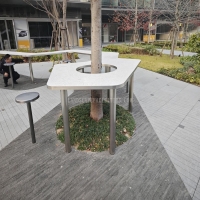Welcome to the website for landscape facilities products and knowledge.
What are the noise reduction techniques used in landscape bar counters for commercial settings?
In commercial hospitality environments, landscape bar counters serve as vibrant social hubs yet frequently suffer from excessive noise levels that compromise guest experience. Implementing effective noise reduction techniques has become essential for designers and operators seeking to maintain energetic atmospheres while ensuring acoustic comfort.
Strategic spatial design forms the foundation of noise control. Dividing large open areas into smaller zones with varied ceiling heights and partial barriers disrupts sound wave propagation. Installing curved or angled surfaces along the bar counter helps diffuse sound energy rather than reflecting it directly toward patrons. These architectural interventions work to break up problematic sound paths before electronic solutions become necessary.
Material selection critically influences acoustic performance. Utilizing sound-absorbing materials for ceilings—such as acoustic panels, fabric-wrapped systems, or perforated wood installations—captures ambient noise before it reverberates throughout the space. For bar fronts and counter surfaces, dense materials like quartz composite or thick timber provide both aesthetic appeal and sound damping properties. Even flooring choices contribute significantly; carpet tiles in seating areas contrast with acoustic underlay beneath hard surfaces to reduce impact noise.
Advanced acoustic technologies offer targeted solutions where design alone proves insufficient. Discrete perimeter-mounted sound masking systems emit gentle, frequency-adjusted background sound that reduces perceived noise levels by lowering the dynamic range between ambient and peak volumes. Strategic placement of bass traps in corners addresses low-frequency buildup from music systems, while high-frequency absorption panels handle speech clutter.
Operational considerations complete the acoustic strategy. Training staff to manage audio system levels appropriately and positioning glass racks away from customer areas minimize avoidable noise sources. Incorporating ample soft furnishings—upholstered bar stools, banquette seating, and textile wall coverings—provides additional absorption surfaces that enhance the overall acoustic environment.
Through thoughtful integration of these architectural, material, and technological approaches, landscape bars can achieve the delicate balance between vibrant social energy and acoustic comfort that defines truly successful commercial spaces.
Related search:

Recommendation
An outdoor bar counter with stainless steel and terrazzo materials in an irregular shape